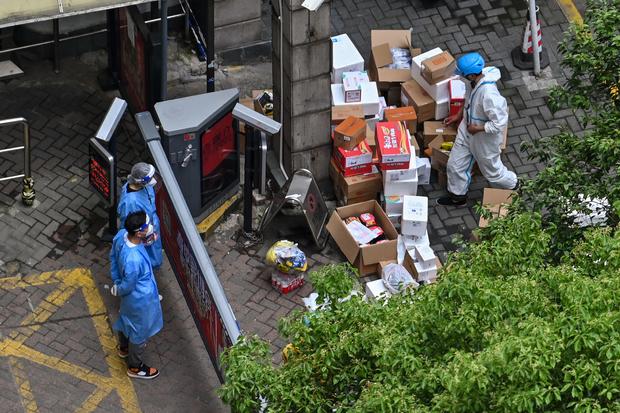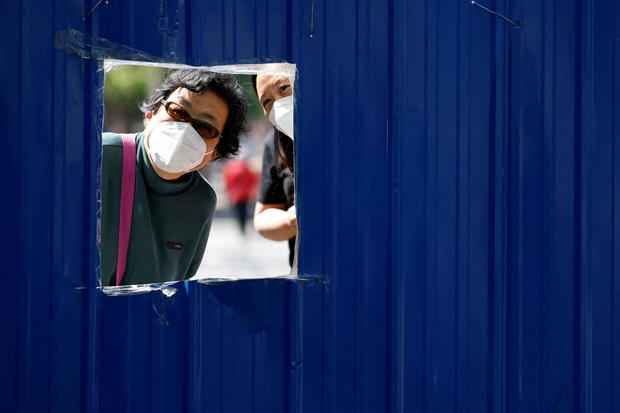Carry off — In the middle of the night, Shanghai resident Lucy said she and her neighbors were forced onto buses and taken hundreds of miles from the closed Chinese metropolis to a makeshift coronavirus quarantine center.
CBS News Senior Foreign Correspondent Elizabeth Palmer says that according to Chinese authorities, more than half of Shanghai’s 25 million residents have been released from lockdown conditions, but as the city battles a major outbreak of COVID-19you would never know. The vast majority remain confined to their homes or neighborhoods.
Hundreds of thousands of virus-positive people have been herded into makeshift facilities like Porcelain does not allow them to quarantine at home. But some residents who tested negative told AFP they were also forced from their homes and taken to camps outside the city, a few hundred kilometers away.
“The police told us that there were too many positive cases in our compound and that if we continued to live here we would all get infected,” Lucy told AFP, using only her first name for privacy reasons. “We had no other choice.”
She said the virus-negative group was sent to a quarantine site containing hundreds of one-room prefab huts in neighboring Anhui province, some 250 miles away, and it was initially unclear where they were going.
Lucy said that she did not know when she would be allowed to return home.
AFP spoke to other Shanghai residents who said healthy, virus-free people in some housing complexes were sent to other provinces for quarantine. One said his neighbors had protested and refused to join.
Another from the city’s Jing’an district told AFP she was taken, along with dozens of others from her residential compound, to a one-room quarantine center in Anhui one night.
“We all receive calls from the neighborhood committee saying that since there are too many positives in our complex, the negatives must be transferred to hotels for isolation,” said the resident, who preferred to remain anonymous, to AFP.
She said they “felt terrified” at the sight of the temporary accommodation and had “lost confidence in the Shanghai government”.
HECTOR RETAMAL/AFP/Getty
Shanghai remained under a patchwork of different restrictions on Monday as new virus cases fell to around 7,000, with 32 dead.
City authorities have imposed a three-tier system of “freedoms,” though strict local enforcement still seemed to restrict most residents within residential complexes or neighborhoods.
China’s relentless pursuit of a zero COVID policy has left many Shanghai residents chafing under the narrow sidewalks. The Shanghai government did not immediately respond to a request for comment.
Officials in the economic hub are likely to be under more pressure than elsewhere to achieve “community-level COVID-zero,” meaning no transmission outside the quarantine centers, according to Yanzhong Huang, a senior council member. of Foreign Affairs based in New York.
“When faced with strong pressure from above to achieve zero COVID goals, these excessive and heavy-handed measures become more likely.”
“Moving negative people could be considered a preventative strategy, with the expectation that more positive cases may be found if they remain there,” Huang added.
Chinese officials are routinely fired after virus outbreaks for perceived lapses in COVID control.
Tens of thousands of close contacts of virus cases have been quarantined in neighboring provinces, according to the official Xinhua news agency, but the relocation of negative cases has not been mentioned in official media.
Shanghai authorities have faced widespread criticism after initially announcing four-day staggered lockdowns in different parts of the city that were later not lifted.
Tall metal barriers have been erected around some gated complexes in recent days as part of measures described as a “hard lockdown”.
Palmer of CBS News reports that while most of Shanghai remains under restrictions, city officials have made efforts to get essential workers back to work in a bid to get China’s economic hub spinning again. Farmworkers have been told to return, and some factories have even brought back staff, but in some cases they are forced to stay in factories day and night to limit mixing in the community.
CARLOS GARCIA RAWLINS/REUTERS
As Palmer reports, China’s shutdowns are causing labor shortages and broken supply lines, and US companies have warned they will cost both China and the global economy billions of dollars. That is partly why the other COVID outbreak, in the capital city of Beijing, has caused such alarm.
May 1 is a big holiday in China, but on Sunday, Palmer said Beijing was quiet except for the sights and sounds of mass COVID testing. Yet despite 21 million residents being ordered to get tested multiple times in the past week, cases have continued to rise.
Authorities have yet to declare a full lockdown on Beijing, but they are slowly moving in that direction.
New barricades were erected over the weekend around buildings with confirmed COVID cases. Entertainment venues, including the new Universal amusement park, were closed and restaurants were only open for takeout over the holiday weekend.


